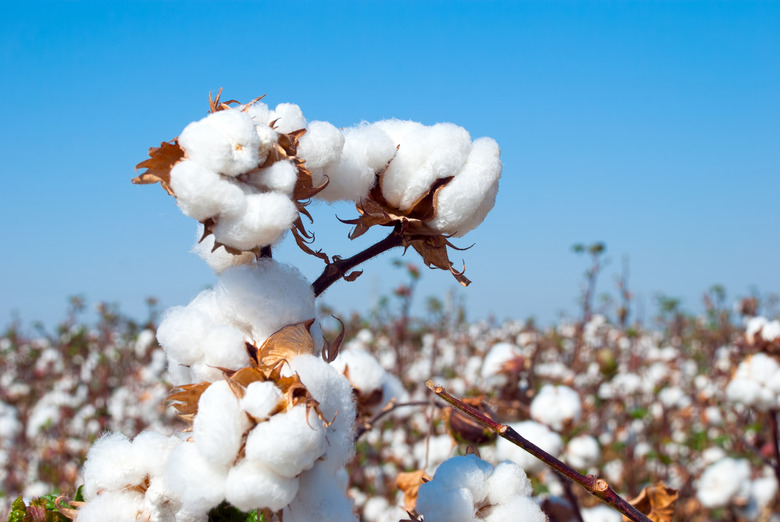Why Is Cotton Absorbent?
The most effective bath towels are made of 100 percent cotton because cotton is most efficient at absorbing or soaking up water. Cotton is able to absorb up to 27 times its weight in liquid water, according to Cotton Inc. Cotton's absorbency is also useful in what is known as "recreational performance apparel"–clothes used in jogging, exercise and sports. Cotton's absorbent properties occur due to a number of reasons, including its specific molecular structure and the structure of water.
Structure of Water
Structure of Water
Part of the reason that cotton is so absorbent lies in the reaction of the differing molecular structures of cotton and water, according to Cotton Inc. Water molecules are made up of one atom of oxygen joined to two atoms of hydrogen. Each oxygen atom has a negative charge, while the hydrogen atoms have a positive charge. This creates a magnetic or "dipolar" attraction that binds the atoms together into a water droplet and also allows water to bond with or attach to any adjacent molecules which contain an opposite charge, such as cotton molecules.
Structure of Cotton
Structure of Cotton
Unlike simpler water molecules, cotton is made up of more complex series of atoms, which are linked into what are called "polymer molecules." These polymer molecules link up in repetitive patterns or chains, creating pure cellulose, a substance which makes cotton absorbent, according to Cotton Inc. One reason cellulose makes cotton absorbent is that it contains a negative charge, which helps attract "dipolar" water molecules and absorb them. Another reason is cotton's "hydrophilic properties."
Hydrophilic Properties
Hydrophilic Properties
The cellulose in cotton has what is referred to in chemistry as "hydrophilic properties," according to Cotton Inc. The word "hydrophilic" actually means water loving or water attracting (hydro is the Greek word for water and philic or philia means loving). A hydrophilic molecule, such as those that occur naturally in cotton cellulose, is the exact opposite of a "hydrophobic" or water repelling molecule. Hydrophobic molecules often are found in man-made fabrics that are oil or petroleum based, according to Cotton Inc. This makes them less likely to absorb moisture.
Capillary Action
Capillary Action
Another reason why cotton works to absorb liquid is "capillary action," where cotton fibers are able draw or suck in water like a straw through the interior of the fiber. Capillary action is present both in the fiber of the cotton plant and cotton fabric. Once drawn in through the fibers, the water is then stored in the interior cell walls, according to Textile Glossary.com. The water in the cell walls of the cotton eventually dries out or evaporates.
Demonstration
Demonstration
Capillary action in cotton can be demonstrated, according to Science Fair Projects World, by using a long, thin piece of cotton cloth with one end dipped in a full container of water. The other end of the cotton is placed over an empty container positioned just underneath the full container. Over a 24 hour period, the water in one container will be drawn in and travel along the piece of cotton into the empty container via capillary action.
Man-Made Fibers
Man-Made Fibers
Some man-made fibers and fabrics are marketed with claims that they "wick" away moisture as efficiently as cotton. According to Fabrics.net, man-made nylon and polyester fibers do not absorb water or perspiration well. Rayon, however, which is made from a cellulose that is similar to cotton, does absorb water, according to Fabrics.net.
References
Cite This Article
MLA
Norton, Kim. "Why Is Cotton Absorbent?" sciencing.com, https://www.sciencing.com/cotton-absorbent-6662538/. 13 March 2018.
APA
Norton, Kim. (2018, March 13). Why Is Cotton Absorbent?. sciencing.com. Retrieved from https://www.sciencing.com/cotton-absorbent-6662538/
Chicago
Norton, Kim. Why Is Cotton Absorbent? last modified March 24, 2022. https://www.sciencing.com/cotton-absorbent-6662538/
